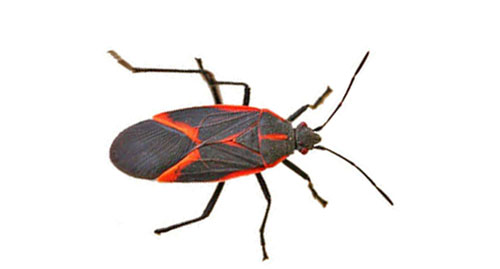Box Elder Bugs
The first insects we see every early spring are boxelder and elm seed bugs. These insects become a major problem when homeowners find they can’t even enjoy a day outside without these insects covering the entire perimeter of their home and then making their way inside.
Indoors, these bugs can be a major problem. While they don’t normally cause structural damage to homes or contaminate food sources (individuals will occasionally show up in dried beans and flour if not stored in tightly sealed containers), they can be a source of filth, odor and displeasure due to their sheer numbers.

General Information
Both of these insects nest and breed in and around these trees, and some even choose to breed on the ground in grassy brushes. They are most often seen on the South/West side of homes, as they enjoy being in the sun.
Elm Seed Bugs are distinguishable from Box Elder Bugs in 3 important ways: At around a third of an inch long they are much smaller than Box Elder Bugs. There is a dark triangle spot on their backs that points backwards. They have white bands on their abdomens.
Boxelder Bugs
Boxelder bugs are black plant bugs and are named for their primary host, the boxelder tree. It is found primarily on boxelder trees, as well as maple and ash trees. Box elder bugs are black in color and have red lines along the thorax sides. They are often found in homes and on the sunny exterior sides of buildings. Depending on their location, boxelder bugs breed once, twice, or three times yearly. Boxelder bugs breed during the summer and early fall seasons. Boxelder bugs do not reproduce inside homes, but find their way inside through windows, doors, ceiling lights, soffit and dryer vents, outdoor faucets, and along siding.
A bigger nuisance to homeowners, they seek and enter houses in colonies of hundreds, even thousands of insects as cold weather approaches, congregating in walls and warm basements, making themselves at home all through winter and occasionally emerging into kitchens, living rooms, bed rooms and other human-inhabited spaces. Boxelder bugs, though mostly scentless, give off a pungent odor when disturbed or crushed. Boxelder bugs are not harmful to humans or pets. They do not bite or sting; however, if you squash them on your drapes or wall, they will stain.
In late summer and autumn, then they gather in groups much like swarms of bees on the sun-facing, preferably white side of homes and garages where their sheer numbers will discolor the building’s side if allowed to stay.
Elm Seed Bug
The elm seed bug, a native of Europe, was first identified in the United States in Idaho in 2012 and in Oregon in 2013. Elm seed bugs look a lot like boxelder bugs. Their basic shape is the same but adult elm seed bugs are about 1/3 inch long and appear to be black or dark brown. When inspected up close, they have a rusty, red colored back to them and a distinct triangular marking on their backs.
Elm seed bugs feed mostly on elm seeds, but can be found on other trees, such as the linden. Luckily, the bugs are not a concern for the health of elm trees, but they have become a nuisance pest, similar to boxelder bugs, by entering homes and buildings in the spring, late summer and fall. While these pests are unpleasant for a number of reasons, one of the greatest is their foul smell. This stench is only increased when the bugs are squashed.
The main problem with elm seed bugs is they can live a long time. In fact, most will live 3-5 years causing them to have to migrate out of bad weather looking for a good place to live for winter. This means an infestation, when not properly taken care of, will fester and grow over time, only leading to more problems.
How Altus Pest Control Can Get Rid of Boxelder Bugs & Elm Seed Bugs
If boxelder or elm seed bugs do infest your home, it may be time to call Altus Pest Control. Don’t let the problem fester, instead call and get it taken care of sooner rather than later.
Indoor and outdoor boxelder & elm seed bug control are interrelated. Destroying colonies outdoors means fewer bugs looking for a way into your home come fall. Denying places in your home for them to overwinter, means fewer numbers of them laying eggs in your trees next spring and summer.
Aluts Pest Control has done extensive research and product testing and have come up with a very effective treatment program. For optimum protection, season-long control is highly recommended. Our staff can help you select the program that is right for you.
CONTACT US TODAY TO DISCUSS YOUR SPECIFIC PEST CONTROL NEEDS! (541) 709-5033
